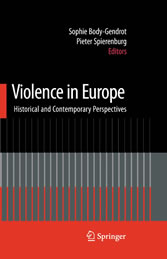Suchen und Finden
Title Page
3
Copyright Page
4
Acknowledgments
5
Table of Contents
6
Contributors
8
Introduction
10
References
18
Part I Contested Definitions
19
Violence: Reflections About a Word
20
Definitions by Anthropologists
21
Intentional Encroachment upon the Physical Integrity of the Body
24
Remaining Problems
25
Conclusion
31
References
32
Violence as an Essentially Contested Concept
33
Introduction
33
Defining Violence Restrictively
36
Defining Violence Inclusively
38
Philosophical Clarification
39
Implications
42
References
44
Part II Long-Term Trends
47
Homicide in Scandinavia: Long-Term Trends and Their Interpretations
48
The Long-Term Trends- AnOverview
48
Medieval and Early Modern Homicide Rates - Uncertain Estimations
52
Discontinuities and Regional Differences. AMore Complicated Picture of the Long-Term Trends in Homicides
57
Explanations and Interpretations
60
Conclusions
65
References
66
Violence in France's Past: An Anthropological Approach
70
Violence and Domestic Reproduction
73
A Culture of Honour
77
The Internalization of the Judicial Norm and the Decline of Rural Violence
79
References
82
The Fall and Rise of Homicide in Ireland
84
Introduction
84
Famine (1845 to 1854)
85
Consolidation (1895 to 1904)
88
Stasis (1945 to 1954)
90
Prosperity (1995 to 2004)
92
Conclusion
94
References
96
Part III Contemporary Trends
98
Violence in Present-Day France: Data and Sociological Analysis
99
LowIntensity Violence
99
Fatal Violence is at theLow-Water Mark
101
Fragmented Violence
102
Social Relegation, Provocation, Exasperation (Robert, 1999, 2002
108
Policies Run onFashion, not on the Basis of Evaluation
111
Conclusion
115
References
116
From Old Threats to Enigmatic Enemies: The Evolution of European Policies from Low Intensity Violence to Homegrown Terrorism
118
Introduction
118
Why the Global Context Leads to More Violence
123
Ethnic Forms of Violence in Relegated Neighborhoods
125
Why Violent Clashes Between Male Youths and the Police are Persisting in France
126
Are Criminogenic Areas the Breeding Ground of Homegrown Terrorism?
129
What Should beDone?
134
Conclusion
137
References
138
Part IV Gendering Violent Practices
141
The Language of Violence: Symbolic Body Parts in Marital Conflicts in Early Modern France
142
Different Horizons of Meaning
144
Spousal Murder at Court
147
Spousal Murder in Narrative Literature
149
TheSymbolic Meaning of theBody
150
Violence and Social Sense
156
References
157
Negotiating Violence and Gender: Security and the Night Time Economy in the UK
161
Gendering Nightlife and the Rise of the Female Bouncer
162
Gendering 'Violence Work': Situating Diffusion
166
Discussion and Conclusions
170
References
171
Part V Politics, War and Violence
174
Violence and War: Measuring Homicide in Belgium (1900-1950)
175
Introduction
175
Homicide in the XXth Century: A Long Decline and Recent Upsurges
176
Methodological Issues on the Reliability of Data and Epistemological Issues on the Socially Constructed or Substantive Character of Interpersonal Aggression
176
Characteristics of the Multi-Secular Decline
177
Sources for Measuring Violent Death in Belgium
178
Judicial Statistics: Counting the Perpetrators
178
The Belgian Judicial System, Statistical Material, and Homicide
178
Legal-Institutional Classifications of Homicide
179
Medical Statistics: Counting the Victims
181
Homicide Rates in Belgium (1901-1950)
182
General Patterns
182
Medical Statistics
182
The Figures of Justice
188
A Geographical Pattern of Homicide
191
Homicide in Belgium in Peaceand War: Civilization or Brutalization?
199
References
200
Democratization and Violence: European and International Perspectives
203
Democratization, Democracy and Violence
203
Deficiency and Vulnerability: Democratization and Violence
204
Democracy and Violence: Tensions of Liberal Inclusion
207
Autocracy, Totalitarianism and Violence: 'Repressive Inclusion'
210
Transitions Toward Democracy: Cumulative Disadvantages and 'Booms' of Violence
213
Advantages of Democracy?
219
References
220
Violence and Violence-Control in Long-Term Perspective: 'Testing' Elias in Relation to War, Genocide, Crime, Punishment and Sport
224
Introduction
224
A Deeply Rooted Contemporary Belief
225
Towards a Typology of Human Violence
226
A Figurational 'Take' on the Concepts of Violence and Aggression
229
SomeSociological Reflections on Warfare Viewed in Long-term Perspective
230
SomeFigurational Reflections on Modern War
234
Genocide in the Process of Civilization
237
Aspects of Crime, Punishment and Sport in the 'Civilising' of the West
241
Conclusion: Trends in Violence and Elias's Thesis
243
References
244
Index
247
Alle Preise verstehen sich inklusive der gesetzlichen MwSt.









